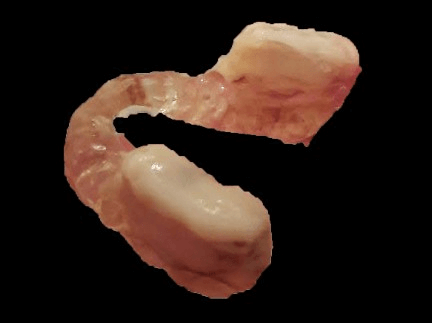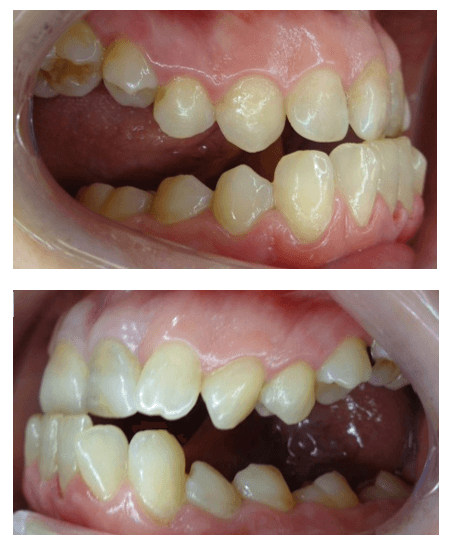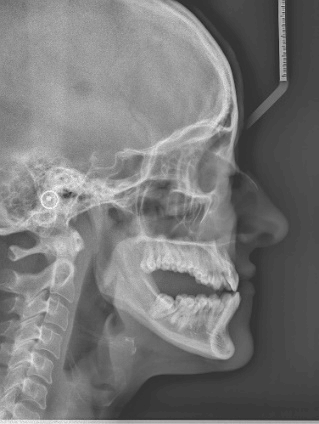Significant Occlusal Alteration Following Use of an Intra-Oral Removable Device: A Case Report
A B S T R A C T
Intra-oral removable devices are readily available and increasingly advocated for the correction of body posture and alleviation of associated musculoskeletal symptoms. The precise clinical application and mechanism of action is poorly understood and their use remains controversial. We present the case of a 47-year-old female where prolonged use of such a splint resulted in significant and adverse occlusal alteration.
Keywords
Intra-oral appliances, lateral open bite, posture correction
Introduction
Studies have been carried out to understand the relationship between dental occlusion and posture by observing postural changes in patients following removable appliance therapy, such as, mandibular orthopaedic repositioning appliances (MORA). Milani et al. (2000) reported observed changes to posture in an experimental group of patients after four weeks of MORA wear [1]. Another study reported that the nature of changes in posture can depend on the lower jaw position when the appliance is worn [2].
Whilst existing literature may suggest possible use of dental appliances to treat altered body posture, their use remains controversial and potential adverse effects have not been well documented. A poorly designed appliance can cause various undesirable effects which include discomfort and occlusal alteration [3]. We report on such a case that presented with significant bilateral lateral open bites as a result of wearing a removable appliance primarily prescribed to treat neck pain and posture.
Case Report
A 47-year-old healthy female presented on our orthognathic clinic with concerns her teeth did not meet resulting in a restricted diet and increased difficulty and time required to masticate food. She reported a history of back pain and poor posture, which had been alleviated following the use of a lower removable appliance prescribed by a non-medically trained practitioner 6 years prior. Coupled with information provided and web-based research she progressively increased the posterior height of the appliance with self-cured acrylic bought online (Figure 1). The bite plane extended posteriorly from the permanent canines to cover all premolars and molars. She reported progressive worsening of the lateral open bites which she claimed not to have had prior to appliance therapy.
Intra-orally, she presented with a Class III incisor relationship complicated by bilateral lateral open bites measuring 2mm in the upper lateral incisor region increasing posteriorly to over 15mm in the molar regions (Figure 2). The reverse overjet measured 1mm with the only point of occlusal contact occurring with the maxillary right central incisor (Figure 2). She presented with a significant step in the maxillary occlusal plane distal to the canines. Furthermore, the maxillary and mandibular molars had rolled buccally and lingually respectively (Figure 2). Cephalometric analysis confirmed a mild skeletal III pattern with significant reduction and alteration in the maxillary posterior dento-alveolar height and to lesser degree the mandibular posterior alveolar height (Figure 3).
Figure 1: Intra-oral removable appliance with increased height of bite blocks.
Figure 2: Intra-oral views displaying extent of lateral open bites.
Figure 3: Lateral cephalogram highlighting loss of posterior dento-alveolar height and severity of lateral open bite.
The patient was advised to discontinue use of the appliance to allow some spontaneous improvement through eruption of the posterior teeth. A 9-month review revealed improvement in the extent of the lateral open bites (measuring 10mm in the molar regions) with a noticeable increase in crown emergence of the mandibular molars in particular (Figure 4). A further review is arranged in due course in anticipation of continued improvement in the posterior occlusion, thus allowing for possible future comprehensive orthognathic correction.
Figure 4: Intra-oral views showing improvement in extent of lateral open bite 9 months after withdrawal of the appliance.
Discussion
Removable oral appliances and stabilization splints are commonly used in the management of temporomandibular Joint disorders (TMD), in bruxists, for management of obstructive sleep apnoea and by some for correction of body posture to alleviate musculoskeletal symptoms. Minor occlusal changes in response to the use of such devices has been described in the literature [4]. However, severe occlusal alterations resulting in additional complications (compromised oral function, health and aesthetics) impacting on quality of life have seldom been reported. The risk of such extreme deleterious consequences occurring is higher in patients who wear the appliances full-time, over a long period and demonstrate signs of psychological dependence on the appliance [4, 5].
The literature suggests the occlusion and the associated position of the mandible conveys somatic sensory information that influences cranio-cervical muscles and body posture [6]. As a consequence, the use of inter-occlusal removable devices have been suggested to alter sensory feedback in turn shaping postural tone and changing body position and the cranio-cervical relationship. The internet has added a new facet to healthcare with consumers ever more armed with information about health conditions through the ease of open access to research of variable quality coupled with intense marketing and social media coverage. This has led to individuals accessing appliances with increasing ease online or over the counter in the belief that they can find a cure without consulting a medical professional. As a result, health care professionals may see an increased number of patients presenting with associated malocclusions in the form of developing anterior open bite due to posterior teeth over-eruption (particularly with partial coverage devices) or posterior lateral open bites due to molar intrusion.
This case report highlights a number of pertinent issues relevant to clinicians who may see patients wearing or have previously worn removable oral devices or splints. Principally, unsupervised, prolonged appliance wear can cause significant harm and alteration of the occlusion impacting on oral health and function in a negative manner. Furthermore, practitioners should be familiar with appliance design and ideal intra-oral fit of such devices in order to mitigate features that may lead to significant occlusal alteration. Finally, patients should be counselled on the need for routine monitoring with a suitably qualified clinician during therapy to avoid development of adverse consequences that may require significant intervention with associated morbidity and cost subsequently to restore oral health and function.
Author Contributions
Pratik K. Sharma contributed in conception and design of study/review/case series, acquisition of data: laboratory or clinical/literature search, analysis and interpretation of data collected, drafting of article and/or critical revision and final approval and guaranteeing of manuscript. Mariam Shahid Noorani contributed in conception and design of study/review/case series, acquisition of data: laboratory or clinical/literature search, analysis and interpretation of data collected and drafting of article and/or critical revision. Nayeem Ali contributed in conception and design of study/review/case series and drafting of article and/or critical revision.
Article Info
Article Type
Case ReportPublication history
Received: Sat 20, Jun 2020Accepted: Thu 02, Jul 2020
Published: Tue 07, Jul 2020
Copyright
© 2023 Pratik Sharma. This is an open-access article distributed under the terms of the Creative Commons Attribution License, which permits unrestricted use, distribution, and reproduction in any medium, provided the original author and source are credited. Hosting by Science Repository.DOI: 10.31487/j.JDOA.2020.02.01
Author Info
Mariam Shahid Noorani Nayeem Ali Pratik Sharma
Corresponding Author
Pratik SharmaCentre for Oral Bioengineering, Institute of Dentistry, Barts and The London School of Medicine and Dentistry, Queen Mary University of London, London, UK
Figures & Tables




References
- R S Milani, D D De Perière, L Lapeyre, L Pourreyron (2000) Relationship between dental occlusion and posture. Cranio 18: 127-134. [Crossref]
- D Ohlendorf, M Riegel, T Lin Chung, S Kopp (2013) The significance of lower jaw position in relation to postural stability. Comparison of a premanufactured occlusal splint with the Dental Power Splint. Minerva Stomatol 62: 409-417. [Crossref]
- R A C Chate, D T Falconer (2011) Dental appliances with inadequate occlusal coverage: a case report. Br Dent J 210: 109-110. [Crossref]
- L Brayer, J Erlich (1976) The night guard: its uses and dangers of abuse. J Oral Rehabil 3: 181-184. [Crossref]
- S E Widmalm (1999) Use and abuse of bite splints. Compend Contin Educ Dent 20: 249-254. [Crossref]
- G Ormeño, R Miralles, H Santander, R Casassus, P Ferrer et al. (1997) Body position effects on sternocleidomastoid and masseter EMG pattern activity in patients undergoing occlusal splint therapy. Cranio 15: 300-309. [Crossref]
